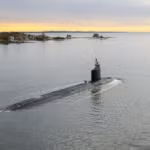RTC News. Raytheon Technologies last week said its board authorized the repurchase of up to $6 billion of the company’s outstanding stock. The new authorization replaces the previous program, which was instituted a year ago and had $3 billion remaining. The company also announced the appointment of Raja Maharajh as its general counsel, reporting directly to Greg Hayes, chairman and CEO of RTC. Maharajh replaces Frank Jimenez, who is leaving the company. Maharajh has been with the company since 2004 and has served as chief of staff to the chairman and CEO and general counsel of the Pratt & Whitney division.
Done Deals. Defense services and solutions provider Systems Planning and Analysis (SPA) last week acquired Arena Technologies, which provides the space and intelligence community with systems engineering and advisory services. Terms of the deal were not disclosed. SPA said the deal gives it access to new customers and strengthens its position in the space domain. “Consolidation has created a void in the technical advisory market, and this transaction marks the first of many investments we are making to fill it,” William Vantine, president and CEO of SPA, said in a statement. Arena’s financial adviser on the deal was G2 Capital Partners. Separately, ManTech International completed its $350 million acquisition of Gryphon technologies from AE Industrial Partners, adding over 1,500 new employees and expanding its footprint in the Department of Defense and ability to provide model-based systems engineering, predictive analytics and cloud engineering to agencies such as the Navy, Air Force and Defense Advanced Research Projects Agency.
Magnus Confirmed. The Senate last Tuesday confirmed Chris Magnus to be the new commissioner of Customs and Border Protection. The 50 to 47 vote had one lone Republican in support, Susan Collins of Maine. Magnus is the chief of police in Tucson, Ariz. In announcing his nomination earlier this year, the White House said Magnus has a reputation for relationship building between the police and the community and has experience with immigration issues based on his leadership of the Tucson police department since 2016.
People News. L3Harris Technologies has elected retired Navy Adm. Harry Harris, who is also a former U.S. Ambassador to South Korea and commander of U.S. Pacific Command, to its board of directors, expanding the board to 13 members. Harris, 65, was the Ambassador to the Republic of Korea from 2018 until 2021 after retiring from the Navy following a 40-year career. Leonardo DRS last week named Philip Perconti as the company’s chief technology officer, leading corporate research and development and accelerating innovation. He most recently served as deputy assistant secretary of the Army for research and technology and was the Army’s chief scientist.
Coast Guard Cyber. If you want to learn more about how the Coast Guard operates in cyberspace, tune in on Wednesday, Dec. 10 at 1 p.m. EST to a webinar that will be hosted by the service. Lt. Cmdr. Stephen Albert of the Office of Cyber Forces (CG-791) will provide an overview of his organization’s cyberspace strategies and policies focusing on the Coast Guard’s defensive actions and preventative measures to protect the service’s systems from cyber threats. Contact Stephanie France, stephanie.france@uscg.mil, for more information.
Hawley/VCJCS Nom. Sen. Josh Hawley (R-Mo.) signaled he may potentially oppose Adm. Chris Grady’s nomination to be the next vice chairman of the Joint Chiefs of Staff over Grady’s answers during his confirmation hearing on potential changes to DoD’s force posture construct. Hawley pressed Grady on whether he believes the Pentagon is doing enough to prioritize its force construct for the Indo-Pacific and potential conflict with China. “Certainly, if the pacing threat is in the INDOPACOM theater then…it will be important to provide [that commander] with the resources he needs to help shape that environment and make those priority-based decisions based on the threat,” Grady said. Hawley pushed back that he thought Grady’s answers were not specific enough on how DoD would prioritize for the Indo-Pacific region. “Frankly, you’re evading my questions. You haven’t given me a straight answer on any of my questions, yet” Hawley said. “If I can’t get any further clarity from you on this, if you’re position is in fact that you want to abandon the 2018 [National Defense Strategy] force posture, you won’t be confirmed with my vote.”
SASC Advances Noms. The Senate Armed Services Committee on Dec. 8 voted to advance three nominations for senior Pentagon civilian positions. The list includes John Sherman to be the Pentagon’s chief information officer, Ashish Vazirani to be deputy under secretary of defense for personnel and readiness and Carrie Ricci to be the Army’s general counsel. The nominations were immediately reported to the floor for full Senate consideration.
Saudi FMS. The Senate on Dec. 7 voted 67-30 to stop a bipartisan measure that would have blocked a $650 million foreign military sale with Saudi Arabia. The measure was introduced by Sens. Bernie Sanders (I-Vt.), Rand Paul (R-Ky.) and Mike Lee (R-Utah) over human rights concerns in Saudi Arabia and Riyadh’s continued involvement in the war in Yemen. The $650 million arms deal was approved by the State Department in November and includes AMRAAM missiles. “The FMS case at issue is fully consistent with the Administration’s pledge to lead with diplomacy to end conflict in Yemen and end U.S. support for offensive operations in the war in Yemen, while also ensuring that Saudi Arabia has the means to defend itself from Iranian-backed Houthi air attacks,” the White House wrote in a statement prior to Tuesday’s vote.
DOT&E Reports. The Pentagon’s upcoming annual report from the Director of Operational Test and Evaluation detailing the latest on the department’s weapon systems program will include an unclassified public version and one with “controlled unclassified information” (CUI) not released to the general public. Raymond O’Toole, the acting head of the DOT&E office, said the change was intended to avoid adversaries having sensitive information on certain program’s potential technical challenges. “I thought it very important to provide Congress and the Secretary the test evaluation details that shouldn’t wind up in our adversaries’ hands, hence the new CUI version of the annual report,” O’Toole said during a Defense One discussion.
JAGM. Marines completed operational testing of the Joint Air-to-Ground Missile (JAGM) on the A-1Z Viper at Eglin Air Force Base, Fla., demonstrating its capability against maritime targets. In November the team conducted multiple live-fire events, testing all modes of the JAGM against “realistic operational threats,” the Navy said. AH-1Z pilots tested the JAGM off the coast of Florida and hit moving target boats up to seven km away using both laser and radar sensors for guidance. The Navy said all of the launches were successful under planned test conditions. Over the following weeks the team is set to conduct land-based operational testing to support using the JAGM on the AH-1Z at Yuma Proving Ground, Ariz. The missile is designed with a seeker that combines capabilities of current Hellfire missile variants, with a semi-active laser guidance and millimeter wave radar to hit enemies in the open. JAGM is expected to reach initial operational capability on the Marine Corps’ AH-1Z in 2022. “The successful event today gives us confidence that we can move into full rate production next year,” Capt. Alex Dutko, Direct and Times Sensitive Strike (PMA-242) program manager, said in a statement.
DDG-131. Huntington Ingalls Industries’ Ingalls Shipbuilding division started fabricating the Arleigh Burke-class (DDG-51) destroyer the future George M. Neal (DDG-131) on Dec. 6. DDG-131 will be the 6th Flight III destroyer, featuring an improved air and missile defense radar. The company has previously delivered 33 DDG-51 destroyers to the Navy and is also currently building the future Lenah Sutcliffe Higbee (DDG-123), Jack H. Lucas (DDG-125), Ted Stevens (DDG-128) and Jeremiah Denton (DDG-129). DDG-131 is named after a Korean War veteran who won the Navy Cross for actions attempting to rescue a fellow service member.
CH-53K. Marine Operational Test & Evaluation Squadron One (VMX-1) conducted the first over-the-horizon heavy lift and troop transport ship-to-shore operations using a CH-53K King Stallion from Nov. 19-21, the Marine Corps said on Dec. 3. These exercises are useful for concepts like expeditionary advanced base operations and distributed operations. The service said VMX-1 is evaluating the helicopter’s ability to meet program specification for over-the-horizon heavy lift evolution. Specifically, the aircraft is being tested for its capability to transport a 27,000-pound light armored vehicle from the Wasp-class amphibious assault ship USS Iwo Jima (LHD-7) to an ashore landing zone. In the test, the CH-53K covered up to 220 nautical miles roundtrip without refueling. The Marine Corps is working through initial operational test and evaluation of the CH-53Ks before fielding them to the Fleet Marine Force.
Super Hornets. The Navy awarded Boeing a $366 million modification on Dec. 8 to increase the ceiling to extend the service lives for up to 32 F/A-18E/F Super Hornet aircraft. Work will be split between San Antonio(80 percent) and St. Louis (20 percent) and is expected to be finished by May 2024. No funds were obligated at the time of award but will be provided to individual orders as they are issued.
Top Priorities. While the House appropriations bill is not directly in his purview, House Armed Services Committee Chairman Adam Smith (D-Wash.) says his first defense spending priority “would be to get the appropriations bills done so that we actually spend money, and I don’t mean that facetiously because it’s really important,” he said. “We’re trapped in battles over a thousand different things, but the basic running of the government continues to be enormously important, and we’ve got to make sure that Congress functions to do that because a CR (continuing resolution) at $740 billion is worse than a full appropriations [bill] at $700 billion. The ability to do the appropriations normally is invaluable. The other huge priority is innovation and updating and integrating our weapons systems so that they’re more survivable and our information systems work better. That’s where warfighting is going.”
Wedgetail? U.S. Air Force officials have said that the service is mulling a buy of the Boeing E-7 Wedgetail to replace the venerable E-3 Airborne Warning and Control (AWACS) for air moving target indication, and Air Force Secretary Frank Kendall says that E-7 “is under consideration along with some other options.” Kendall says that one of the problems of the Wedgetail and other large, conventional aircraft is “the increasing reach of [enemy] standoff weapons” to shoot down such aircraft. Wedgetail “would give us a much more modern capability” than AWACS, “and it would give us something that would fill a gap temporarily while we figure out what to do longer term, but in general I think we need to move toward more space-based capabilities, but there are some technological limitations which is something we have to work very closely with the intelligence community,” Kendall says.
…Scolese and Haines. The U.S. Space Force’s space based radar has also been under Department of the Air Force consideration for ground moving target indication to replace the Northrop Grumman Joint STARS aircraft, and Kendall says he wants to collaborate with National Reconnaissance Office (NRO) Director Chris Scolese and Director of National Intelligence (DNI) Avril Haines in devising the right mix of air and space sensors for moving target indication. “The types of sensors we’re talking about are traditionally in the U.S. fielded by the intelligence community, but for a different purpose–gathering intelligence and providing it to the national command authority,” Kendall says. “I’ve already entered into some conversations with the director of the NRO. I’ll be talking to the DNI about this, and hopefully we can work together to work on the space-based side of that. The Air Force traditionally has had the airborne responsiblities for similar sensors so we’ll be seeing what kind of a mix to satisfy both the air and ground moving target needs we have will be the right mix to go forward.”













